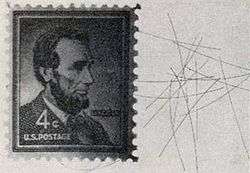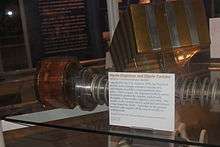Project West Ford
Project West Ford (also known as Westford Needles and Project Needles) was a test carried out by Massachusetts Institute of Technology's Lincoln Laboratory on behalf of the United States Military in 1961 and 1963 to create an artificial ionosphere above the Earth.[1] This was done to solve a major weakness that had been identified in US military communications.[2]

History

At the height of the Cold War, all international communications were either sent through undersea cables or bounced off the natural ionosphere. The United States Military was concerned that the Soviets might cut those cables, forcing the unpredictable ionosphere to be the only means of communication with overseas forces.[1]
To mitigate the potential threat, a ring of 480,000,000[3] copper dipole antennas (needles which were 1.78 centimetres (17.8 mm; 17,800 μm; 0.70 in; 700 thou) long and 25.4 micrometres (1.00 thou) [1961] or 17.8 micrometres (0.70 thou) [1963] in diameter)[4][5] were placed in orbit to facilitate global radio communication. The length was chosen because it was half the wavelength of the 8 GHz signal used in the study.[1] The dipoles collectively provided passive support to Project Westford's parabolic dish (located in the town of Westford) to communicate with distant sites. In 1958, at MIT’s Lincoln Lab, Walter E. Morrow started Project Needles.[1]
A failed first attempt launched on 21 October 1961;[5] the needles failed to disperse. The project was eventually successful with the 9 May 1963[5] launch, with radio transmissions carried by the man-made ring. However, the technology was ultimately shelved, partially due to the development of the modern communications satellite and partially due to protests from other scientists.[1][2]
The needles were placed in medium Earth orbit at an altitude of between 3,500 and 3,800 kilometres (2,200–2,400 mi) at inclinations of 96 and 87 degrees. They have contributed to Earth's orbital debris.[6]
British radio astronomers, together with optical astronomers and the Royal Astronomical Society, protested the action.[7][8][9] The Soviet newspaper Pravda also joined the protests under the headline "U.S.A. Dirties Space".[10]
The issue was raised in the United Nations where then US Ambassador to the UN Adlai Stevenson defended the project.[11]
Stevenson studied the published journal articles on Project West Ford. Using what he learned on the subject and citing the articles he had read, he successfully allayed the fears exhibited by the vast majority of UN ambassadors from other countries. He and the articles explained that sunlight pressure would cause the dipoles to only remain in orbit for a short period of approximately three years. The international protest ultimately resulted in a consultation provision included in the 1967 Outer Space Treaty.[1][7]
Fifty years later, in 2013, some of the dipoles which had not deployed correctly still remained in clumps, contributing a small amount of the orbital debris tracked by NASA’s Orbital Debris Program Office.[12][13] Their numbers have been diminishing over time as they occasionally re-enter. As of March 2020, 36 clumps of needles were still known to be in orbit.[14][1][15]
Launches
| Satellite | Date | Launch site | Launch vehicle | Launched in conjunction with |
|---|---|---|---|---|
| Westford 1 | 1961-10-21 | Va LC-1-2 | Atlas-LV3 Agena-B | MiDAS 4[16] |
| Westford-Drag | 1962-04-09 | Va LC-1-2 | Atlas-LV3 Agena-B | MiDAS 5 |
| Westford 2 | 1963-05-09 | Va LC-1-2 | Atlas-LV3 Agena-B | MiDAS 6,[16] Dash 1, TRS 5, TRS 6 |
References
- Hanson, Joe (13 August 2013). "The Forgotten Cold War Plan That Put a Ring of Copper Around the Earth". Wired Magazine. Retrieved 18 December 2013.
- Kendall, Anthony (May 2, 2006), Earth's Artificial Ring: Project West Ford, DamnInteresting.com, retrieved 2006-10-16
- Shapiro, I. I.; Jones, H. M.; Perkins, C.W. (May 1964), "Orbital properties of the West Ford dipole belt", Proceedings of the IEEE, 52 (5): 469–518, doi:10.1109/proc.1964.2992 (Abstract)
- Lovell, A. C. B.; M., Ryle; Blackwell, D. E.; Wilson, R. (June 1962), "West Ford Project, Interference to Astronomy from Belts of Orbiting Dipoles (Needles)", Quarterly Journal of the Royal Astronomical Society, 3: 100, Bibcode:1962QJRAS...3..100L
- Wiedemann, C.; Bendisch, J.; Krag, H.; Wegener, P.; Rex, D. (March 19–21, 2001), written at Darmstadt, Germany, Sawaya-Lacoste, Huguette (ed.), "Modeling of copper needle clusters from the West Ford Dipole experiments", Proceedings of the Third European Conference on Space Debris, Noordwijk, Netherlands: ESA Publications Division (published October 2001), 1: 315–320, Bibcode:2001ESASP.473..315W, ISBN 92-9092-733-X
- "Position Paper on Space Debris Mitigation - Implementing Zero Debris Creation Zones" (PDF), International Academy of Astronautics (Final Issue Approved for Publication ed.), Paris, France: International Academy of Astronautics (published October 15, 2005), October 12, 2005
- Terrill Jr., Delbert R. (May 1999), "The Air Force Role in Developing International Outer Space Law" (PDF), Air Force History and Museums Program, Maxwell Air Force Base, Alabama: Air University Press: 63
- Butrica, Andrew J. (ed.), "Beyond the Ionosphere: The Development of Satellite Communications", history.nasa.gov, The NASA History Series, NASA
- Bondi, H. (June 1962), "West Ford Project, Introductory Note by the Secretary", Quarterly Journal of the Royal Astronomical Society, 3: 99, Bibcode:1962QJRAS...3...99.
- "Protests Continue Abroad", The New York Times, London: Reuters (published October 23, 1961), p. 12, October 22, 1961, ISSN 0362-4331
- Teltsch, Kathleen (June 15, 1963), "6 Soviet Space Failures Believed To Have Been Probes of Planets", The New York Times, United Nations, NY (published June 16, 1963), p. 2, ISSN 0362-4331
- Cooney, Michael (2013-10-29), "NASA: On millions of teeny-tiny copper hairs and orbital debris", Network World, retrieved 2013-10-31
- "West Ford Needles: Where are They Now?" (PDF), Orbital Debris Quarterly News, NASA Orbital Debris Program Office, 17 (4), pp. 3–4, October 2013, retrieved 2016-08-13
- James, Yoder (September 2016), stuffin.space, retrieved 2019-05-14
- Barhorst, L.J.C., ed. (January 20, 2008), written at Medemblik, The Netherlands, RAE Table of Earth Satellites, Farnborough, England: Royal Aerospace Establishment / Defence Research Agency, p. 34,
148 pieces, 94 have decayed
- Böckstiegel, Karl-Heinz; Benkö, Marietta (1990). Space Law: Basic Legal Documents. ISBN 9780792300915.